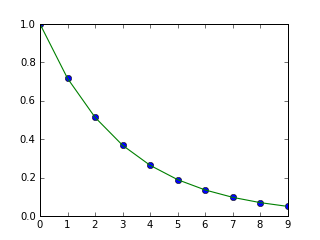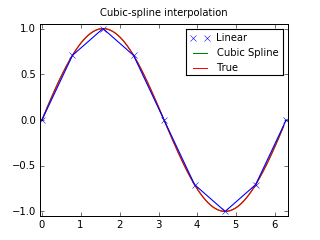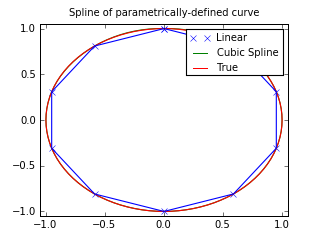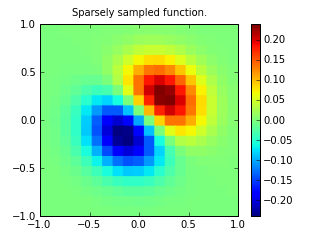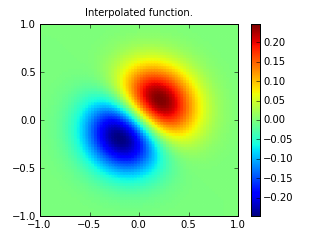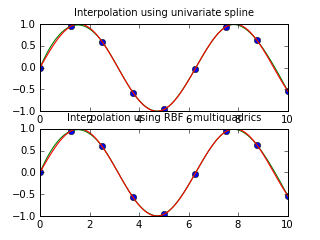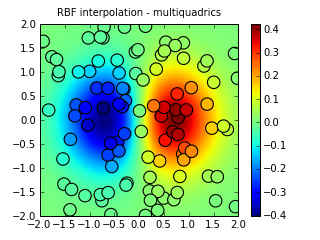Interpolation (scipy.interpolate)¶
There are two general interpolation facilities available in SciPy. The first facility is an interpolation class which performs linear 1-dimensional interpolation. The second facility is based on the FORTRAN library FITPACK and provides functions for 1- and 2-dimensional (smoothed) cubic-spline interpolation.
Linear 1-d interpolation (interp1d)¶
The interp1d class in scipy.interpolate is a convenient method to create a function based on fixed data points which can be evaluated anywhere within the domain defined by the given data using linear interpolation. An instance of this class is created by passing the 1-d vectors comprising the data. The instance of this class defines a __call__ method and can therefore by treated like a function which interpolates between known data values to obtain unknown values (it also has a docstring for help). Behavior at the boundary can be specified at instantiation time. The following example demonstrates it’s use.
>>> import numpy as np >>> from scipy import interpolate>>> x = np.arange(0,10) >>> y = np.exp(-x/3.0) >>> f = interpolate.interp1d(x, y)>>> xnew = np.arange(0,9,0.1) >>> import matplotlib.pyplot as plt >>> plt.plot(x,y,'o',xnew,f(xnew),'-')
(Source code)
Spline interpolation in 1-d (interpolate.splXXX)¶
Spline interpolation requires two essential steps: (1) a spline
representation of the curve is computed, and (2) the spline is
evaluated at the desired points. In order to find the spline
representation, there are two different was to represent a curve and
obtain (smoothing) spline coefficients: directly and parametrically.
The direct method finds the spline representation of a curve in a two-
dimensional plane using the function splrep. The
first two arguments are the only ones required, and these provide the
 and
and  components of the curve. The normal output is
a 3-tuple,
components of the curve. The normal output is
a 3-tuple,  , containing the knot-points,
, containing the knot-points,
 , the coefficients
, the coefficients  and the order
and the order  of the
spline. The default spline order is cubic, but this can be changed
with the input keyword, k.
of the
spline. The default spline order is cubic, but this can be changed
with the input keyword, k.
For curves in  -dimensional space the function
splprep allows defining the curve
parametrically. For this function only 1 input argument is
required. This input is a list of
-dimensional space the function
splprep allows defining the curve
parametrically. For this function only 1 input argument is
required. This input is a list of  -arrays representing the
curve in
-arrays representing the
curve in  -dimensional space. The length of each array is the
number of curve points, and each array provides one component of the
-dimensional space. The length of each array is the
number of curve points, and each array provides one component of the
 -dimensional data point. The parameter variable is given
with the keword argument, u, which defaults to an equally-spaced
monotonic sequence between
-dimensional data point. The parameter variable is given
with the keword argument, u, which defaults to an equally-spaced
monotonic sequence between  and
and  . The default
output consists of two objects: a 3-tuple,
. The default
output consists of two objects: a 3-tuple,  , containing the spline representation and the parameter variable
, containing the spline representation and the parameter variable

The keyword argument, s , is used to specify the amount of smoothing
to perform during the spline fit. The default value of  is
is
 where
where  is the number of data-points
being fit. Therefore, if no smoothing is desired a value of
is the number of data-points
being fit. Therefore, if no smoothing is desired a value of
 should be passed to the routines.
should be passed to the routines.
Once the spline representation of the data has been determined,
functions are available for evaluating the spline
(splev) and its derivatives
(splev, splade) at any point
and the integral of the spline between any two points (
splint). In addition, for cubic splines (  ) with 8 or more knots, the roots of the spline can be estimated (
sproot). These functions are demonstrated in the
example that follows.
) with 8 or more knots, the roots of the spline can be estimated (
sproot). These functions are demonstrated in the
example that follows.
>>> import numpy as np >>> import matplotlib.pyplot as plt >>> from scipy import interpolateCubic-spline
>>> x = np.arange(0,2*np.pi+np.pi/4,2*np.pi/8) >>> y = np.sin(x) >>> tck = interpolate.splrep(x,y,s=0) >>> xnew = np.arange(0,2*np.pi,np.pi/50) >>> ynew = interpolate.splev(xnew,tck,der=0)>>> plt.figure() >>> plt.plot(x,y,'x',xnew,ynew,xnew,np.sin(xnew),x,y,'b') >>> plt.legend(['Linear','Cubic Spline', 'True']) >>> plt.axis([-0.05,6.33,-1.05,1.05]) >>> plt.title('Cubic-spline interpolation') >>> plt.show()Derivative of spline
>>> yder = interpolate.splev(xnew,tck,der=1) >>> plt.figure() >>> plt.plot(xnew,yder,xnew,np.cos(xnew),'--') >>> plt.legend(['Cubic Spline', 'True']) >>> plt.axis([-0.05,6.33,-1.05,1.05]) >>> plt.title('Derivative estimation from spline') >>> plt.show()Integral of spline
>>> def integ(x,tck,constant=-1): >>> x = np.atleast_1d(x) >>> out = np.zeros(x.shape, dtype=x.dtype) >>> for n in xrange(len(out)): >>> out[n] = interpolate.splint(0,x[n],tck) >>> out += constant >>> return out >>> >>> yint = integ(xnew,tck) >>> plt.figure() >>> plt.plot(xnew,yint,xnew,-np.cos(xnew),'--') >>> plt.legend(['Cubic Spline', 'True']) >>> plt.axis([-0.05,6.33,-1.05,1.05]) >>> plt.title('Integral estimation from spline') >>> plt.show()Roots of spline
>>> print interpolate.sproot(tck) [ 0. 3.1416]Parametric spline
>>> t = np.arange(0,1.1,.1) >>> x = np.sin(2*np.pi*t) >>> y = np.cos(2*np.pi*t) >>> tck,u = interpolate.splprep([x,y],s=0) >>> unew = np.arange(0,1.01,0.01) >>> out = interpolate.splev(unew,tck) >>> plt.figure() >>> plt.plot(x,y,'x',out[0],out[1],np.sin(2*np.pi*unew),np.cos(2*np.pi*unew),x,y,'b') >>> plt.legend(['Linear','Cubic Spline', 'True']) >>> plt.axis([-1.05,1.05,-1.05,1.05]) >>> plt.title('Spline of parametrically-defined curve') >>> plt.show()
(Source code)
Two-dimensional spline representation (bisplrep)¶
For (smooth) spline-fitting to a two dimensional surface, the function
bisplrep is available. This function takes as required inputs
the 1-D arrays x, y, and z which represent points on the
surface  The default output is a list
The default output is a list
![\left[tx,ty,c,kx,ky\right]](../_images/math/4600e80651cc380201d6ceabfc9373a31be54ca0.png) whose entries represent
respectively, the components of the knot positions, the coefficients
of the spline, and the order of the spline in each coordinate. It is
convenient to hold this list in a single object, tck, so that it can
be passed easily to the function bisplev. The
keyword, s , can be used to change the amount of smoothing performed
on the data while determining the appropriate spline. The default
value is
whose entries represent
respectively, the components of the knot positions, the coefficients
of the spline, and the order of the spline in each coordinate. It is
convenient to hold this list in a single object, tck, so that it can
be passed easily to the function bisplev. The
keyword, s , can be used to change the amount of smoothing performed
on the data while determining the appropriate spline. The default
value is  where
where  is the number of data
points in the x, y, and z vectors. As a result, if no smoothing is
desired, then
is the number of data
points in the x, y, and z vectors. As a result, if no smoothing is
desired, then  should be passed to
bisplrep .
should be passed to
bisplrep .
To evaluate the two-dimensional spline and it’s partial derivatives
(up to the order of the spline), the function
bisplev is required. This function takes as the
first two arguments two 1-D arrays whose cross-product specifies
the domain over which to evaluate the spline. The third argument is
the tck list returned from bisplrep. If desired,
the fourth and fifth arguments provide the orders of the partial
derivative in the  and
and  direction respectively.
direction respectively.
It is important to note that two dimensional interpolation should not be used to find the spline representation of images. The algorithm used is not amenable to large numbers of input points. The signal processing toolbox contains more appropriate algorithms for finding the spline representation of an image. The two dimensional interpolation commands are intended for use when interpolating a two dimensional function as shown in the example that follows. This example uses the mgrid command in SciPy which is useful for defining a “mesh-grid “in many dimensions. (See also the ogrid command if the full-mesh is not needed). The number of output arguments and the number of dimensions of each argument is determined by the number of indexing objects passed in mgrid.
>>> import numpy as np >>> from scipy import interpolate >>> import matplotlib.pyplot as pltDefine function over sparse 20x20 grid
>>> x,y = np.mgrid[-1:1:20j,-1:1:20j] >>> z = (x+y)*np.exp(-6.0*(x*x+y*y))>>> plt.figure() >>> plt.pcolor(x,y,z) >>> plt.colorbar() >>> plt.title("Sparsely sampled function.") >>> plt.show()Interpolate function over new 70x70 grid
>>> xnew,ynew = np.mgrid[-1:1:70j,-1:1:70j] >>> tck = interpolate.bisplrep(x,y,z,s=0) >>> znew = interpolate.bisplev(xnew[:,0],ynew[0,:],tck)>>> plt.figure() >>> plt.pcolor(xnew,ynew,znew) >>> plt.colorbar() >>> plt.title("Interpolated function.") >>> plt.show()
(Source code)
Using radial basis functions for smoothing/interpolation¶
Radial basis functions can be used for smoothing/interpolating scattered data in n-dimensions, but should be used with caution for extrapolation outside of the observed data range.
1-d Example¶
This example compares the usage of the Rbf and UnivariateSpline classes from the scipy.interpolate module.
>>> import numpy as np >>> from scipy.interpolate import Rbf, InterpolatedUnivariateSpline >>> import matplotlib.pyplot as plt>>> # setup data >>> x = np.linspace(0, 10, 9) >>> y = np.sin(x) >>> xi = np.linspace(0, 10, 101)>>> # use fitpack2 method >>> ius = InterpolatedUnivariateSpline(x, y) >>> yi = ius(xi)>>> plt.subplot(2, 1, 1) >>> plt.plot(x, y, 'bo') >>> plt.plot(xi, yi, 'g') >>> plt.plot(xi, np.sin(xi), 'r') >>> plt.title('Interpolation using univariate spline')>>> # use RBF method >>> rbf = Rbf(x, y) >>> fi = rbf(xi)>>> plt.subplot(2, 1, 2) >>> plt.plot(x, y, 'bo') >>> plt.plot(xi, yi, 'g') >>> plt.plot(xi, np.sin(xi), 'r') >>> plt.title('Interpolation using RBF - multiquadrics') >>> plt.show()
(Source code)
2-d Example¶
This example shows how to interpolate scattered 2d data.
>>> import numpy as np >>> from scipy.interpolate import Rbf >>> import matplotlib.pyplot as plt >>> from matplotlib import cm>>> # 2-d tests - setup scattered data >>> x = np.random.rand(100)*4.0-2.0 >>> y = np.random.rand(100)*4.0-2.0 >>> z = x*np.exp(-x**2-y**2) >>> ti = np.linspace(-2.0, 2.0, 100) >>> XI, YI = np.meshgrid(ti, ti)>>> # use RBF >>> rbf = Rbf(x, y, z, epsilon=2) >>> ZI = rbf(XI, YI)>>> # plot the result >>> n = plt.normalize(-2., 2.) >>> plt.subplot(1, 1, 1) >>> plt.pcolor(XI, YI, ZI, cmap=cm.jet) >>> plt.scatter(x, y, 100, z, cmap=cm.jet) >>> plt.title('RBF interpolation - multiquadrics') >>> plt.xlim(-2, 2) >>> plt.ylim(-2, 2) >>> plt.colorbar()
(Source code)
